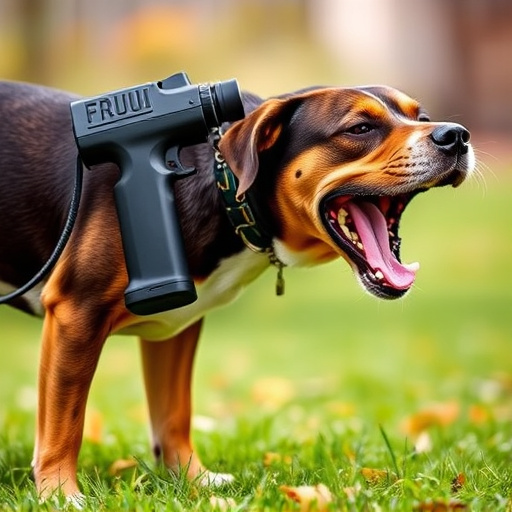Pepper spray, utilizing capsaicin from chili peppers, is a globally adopted tool for subduing aggressive dogs by security forces. Formulations aimed at dogs typically contain 2% to 10% capsaicin, causing temporary blindness, coughing, and breathing difficulties. Modern formulations prioritize safety, minimizing harm to bystanders and non-target species while providing effective canine management in law enforcement scenarios. Police-grade pepper sprays with higher capsaicin concentrations swiftly deter aggressive dogs, enhancing handling efficiency and officer well-being. Safe use requires protective gear, understanding local laws, and applying the spray from a safe distance as a last resort.
“Unleashing control with a unique tool, canine pepper spray stands as a powerful solution for managing aggressive dogs. This article delves into the science behind this innovative approach, focusing on police-grade formulations and their active ingredients. We explore how these specialized sprays offer effective yet safe methods for dog control, providing essential insights for professionals navigating challenging situations. Discover the benefits, safety precautions, and best practices surrounding pepper spray as a game-changer in canine management, especially in dealing with aggressive behavior.”
- Understanding Pepper Spray for Dog Control: Ingredients and Efficacy
- Police-Grade Formulations: Features and Benefits for Canine Management
- Safety Considerations and Best Practices When Using Pepper Spray on Dogs
Understanding Pepper Spray for Dog Control: Ingredients and Efficacy
Pepper spray, also known as oleoresin capsicum (OC), is a popular tool for police and security forces worldwide due to its effectiveness in subduing aggressive dogs. The active ingredient, capsaicin, is derived from chili peppers and is responsible for the burning sensation it causes when coming into contact with mucous membranes. In terms of pepper spray formulation against aggressive dogs, the concentration of capsaicin varies, but typically ranges from 2% to 10%. This powerful chemical irritates the dog’s eyes, nose, and throat, leading to temporary blindness, coughing, and difficulty breathing, which ultimately helps control and subdue the animal.
The efficacy of pepper spray in dog control is well-documented. When used correctly, it can quickly de-escalate potentially dangerous situations without causing permanent harm to the animal. Modern formulations are designed with safety in mind, ensuring minimal impact on bystanders and non-target species. The spray’s ability to create a temporary but effective barrier between the dog and its handler or threat makes it a valuable asset in law enforcement and canine management scenarios.
Police-Grade Formulations: Features and Benefits for Canine Management
Police-grade pepper spray formulations are specifically designed to effectively manage and control aggressive dogs, offering a powerful tool for canine handlers. These specialized products contain higher concentrations of capsaicin, the active ingredient responsible for the burning sensation associated with chili peppers. This enhanced potency ensures that even the most daring or dangerous dogs will be swiftly deterred, providing critical seconds for officers to gain control during high-risk situations.
Beyond its potent ingredients, police-grade pepper spray for dogs boasts advanced features like precise application mechanisms and long-lasting effects, enhancing safety for both canines and humans involved. The benefits extend to improved handling efficiency, as it can incapacitate problematic dogs quickly, allowing handlers to conduct their duties without immediate physical confrontation. This strategic approach not only prioritizes officer well-being but also demonstrates a measured and responsible use of force in canine management scenarios.
Safety Considerations and Best Practices When Using Pepper Spray on Dogs
When considering the use of pepper spray on dogs, especially aggressive ones, safety should always be the top priority. It’s crucial to understand that pepper spray is a powerful irritant designed to disrupt an animal’s behavior temporarily, but it must be deployed responsibly. The formulation of the pepper spray plays a significant role in its effectiveness and safety profile against aggressive canines. Opting for police-grade or professional-strength pepper sprays is recommended as they are typically formulated with higher concentrations of capsaicin, the active ingredient responsible for the burning sensation. This ensures maximum impact on even the most ferocious dogs.
Best practices dictate that the spray should be used as a last resort in situations where the dog’s behavior poses an immediate threat. Trainers or handlers should maintain proper distance and follow up with positive reinforcement techniques after the incident. It’s essential to wear protective gear, including eye protection, during application to prevent any accidental exposure. Additionally, having a clear understanding of local laws regarding pepper spray usage on animals is imperative to avoid legal complications.
In conclusion, police-grade canine pepper spray offers a powerful yet controlled solution for managing aggressive dogs. Its unique formulation combines specialized ingredients to effectively disrupt and deter without causing long-term harm. By understanding the safety considerations and best practices outlined in this article, dog owners and professionals alike can harness the benefits of this tool for enhanced canine control, ensuring both animal welfare and public safety. When used responsibly, pepper spray formulations against aggressive dogs can be a game-changer in navigating challenging situations.
